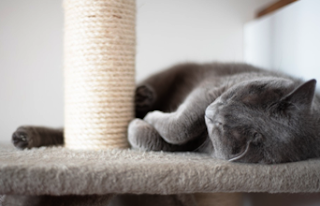Scratching Post That
You Could Ever Make For Your Cat
A cat's need to scratch is just as important as its need for oxygen. This is one area that new cat owners fail to understand. Your cat must scratch (he NEEDS to scratch) and it is your duty to provide something that your cat can paw at whenever he wants to. Basically, your cat should have what is called a “scratching post”.
When shopping for a scratching post it is very important to find one that is sturdy and is made of material that your cat enjoys scratching. And remember, you do not want to go to cheap when it comes to a good scratching post because your cat will literally scratch away an inexpensive post that you will have to replace with more money. It is best to spend a little more now and have it last for a while. A stable scratching post is vital because you do not want the structure to come crashing down on your cat or even worse, your glass table or that antique vase your grandmother gave you.
When it comes to the material that the scratching post will be made of, in my personal experience it is best to go with sisal. Sisal is a rope-like natural covering that is extremely popular with cat owners. It is very similar to a carpet that is not too shaggy but is made of loops that cats absolutely love to paw at.
Most scratching posts that are sold in standard pet stores are typically very small. Standard posts stand less than 3 ½ feet tall. Most are vertical yet some come in a horizontal structure. I myself actually made a 6 foot tall scratching post that sits nicely in the corner of my living room. It is very sturdy and in between the vertical pole I have a 4 foot pole that goes across horizontally, kind of like a cross. These poles are wrapped in sisal. This cross-shaped scratching post allows all three of my cats to enjoy crawling up, hanging out, and scratching away on a tall perch.
If you're not as handy as I am when it comes to building stuff, you can find yourself a nice cat tree that is specifically made for this purpose. They are tall and are built with a top perch which enables the cats to look down as they relax and scratch away in their own little sanctuary. This type of scratching Post also gives a cat somewhere to go when he wants to be alone. You can also place dangling cat toys from the perch and other areas of the post which will give hours upon hours of fun and freedom for your pets.







